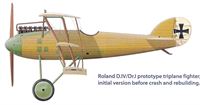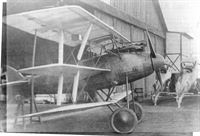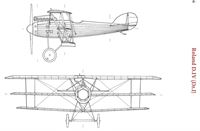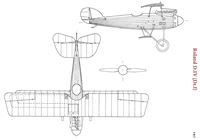
Описание
Страна: Германия
Год: 1917
Fighter
O.Thetford, P.Gray German Aircraft of the First World War (Putnam)
L.F.G. Roland D IV
Built in 1917, this elegant triplane was the first L.F.G. single-seater to feature the clinker-built fuselage which is described in the main text under L.F.G. D VIb. All control surfaces were unbalanced, and ailerons were fitted to both upper and lower wings. The tailplane was adjustable for incidence, but not during flight. Engine, 160 h.p. Mercedes D III.
Описание:
- O.Thetford, P.Gray German Aircraft of the First World War (Putnam)
- W.Green, G.Swanborough The Complete Book of Fighters
- J.Herris Roland Aircraft of WWI (A Centennial Perspective on Great War Airplanes 9)
Фотографии
-
J.Herris - Roland Aircraft of WWI /Centennial Perspective/ (9)
Roland D.IV/Dr.I prototype triplane fighter, initial version before crash and rebuilding.
-
M.Dusing - German Aviation Industry in WWI. Volume 1 /Centennial Perspective/ (84)
Although a triplane, this Roland fighter was designated the D.IV, not the Dr.I. This was the first Roland fighter to use the Klinkerrumpf fuselage construction, which was similar to constructing a wooden boat hull with overlapping boards. (160 h.p. Mercedes engine.)
-
J.Herris - Roland Aircraft of WWI /Centennial Perspective/ (9)
The Roland D.IV / Dr.I used Klinkerrumpf fuselage construction to save construction time.
-
J.Herris - Roland Aircraft of WWI /Centennial Perspective/ (9)
The Roland D.IV/Dr.l rebuilt with a Roland D.VI prototype fuselage after its accident. The stubs for the lower wings from the biplane D.VI prototype are clearly visible.
-
W.Green, G.Swanborough - The Complete Book of Fighters
The D IV was the first Roland fighter to adopt the Klinkerrumpf construction method.
-
J.Herris - Roland Aircraft of WWI /Centennial Perspective/ (9)
Roland D.IV (Dr.I)
-
J.Herris - Roland Aircraft of WWI /Centennial Perspective/ (9)
Roland D.IV (Dr.I)







